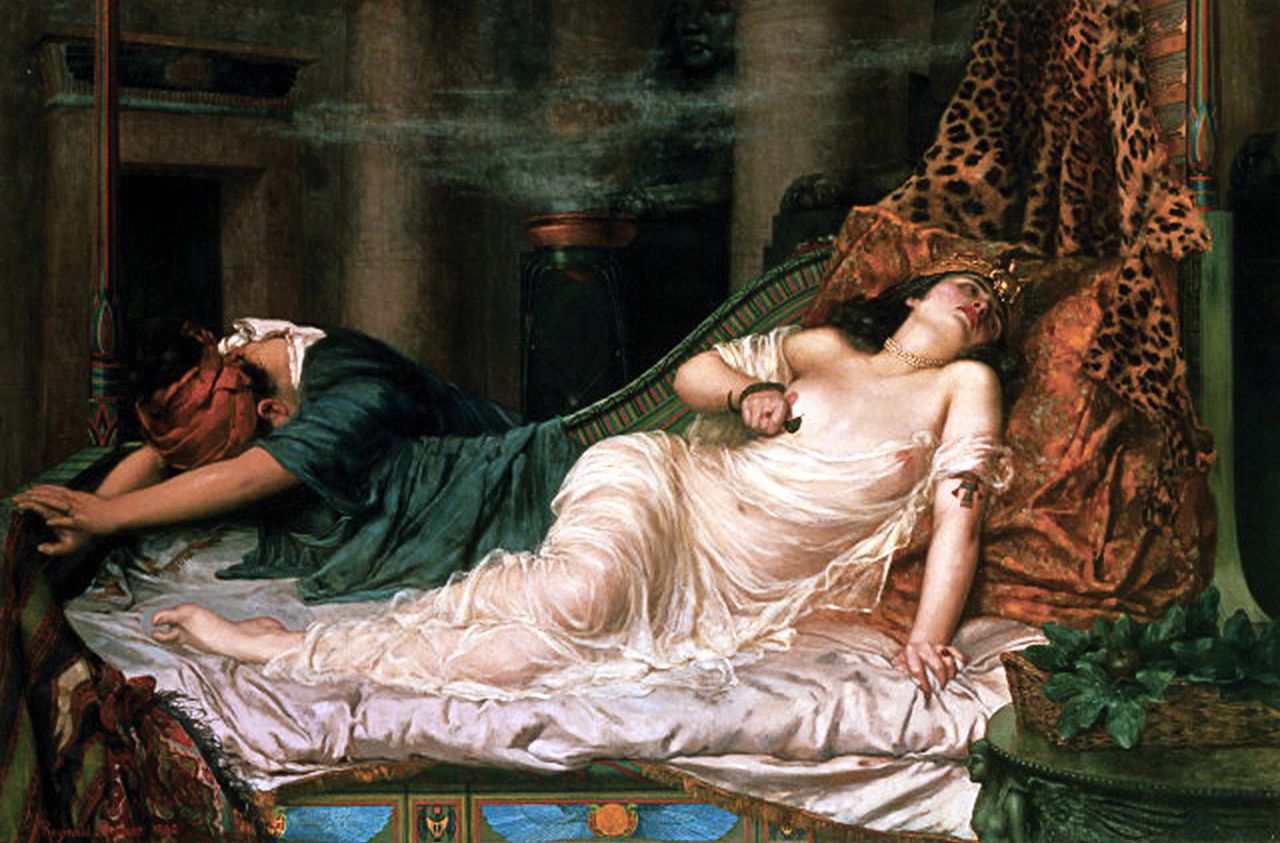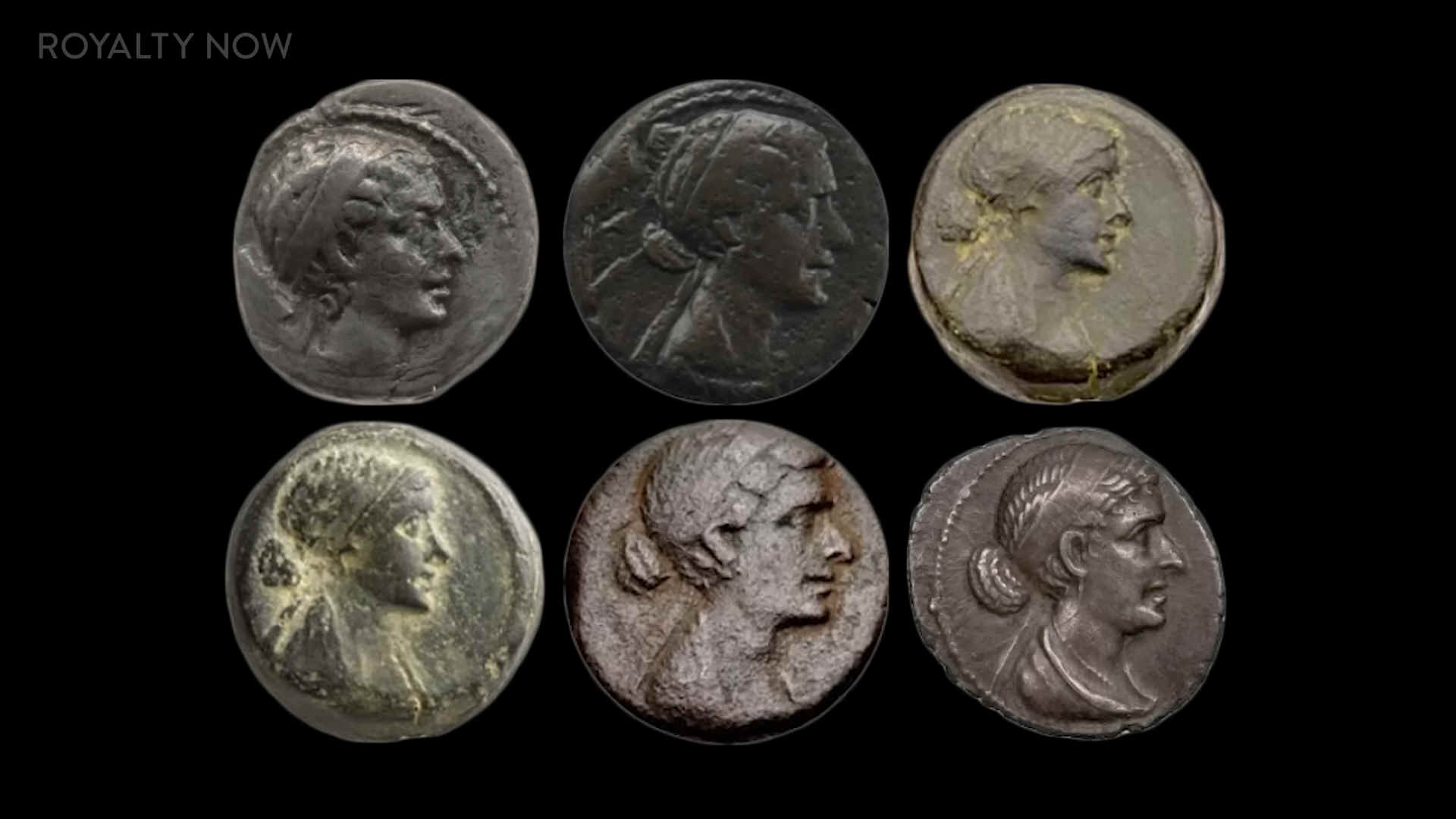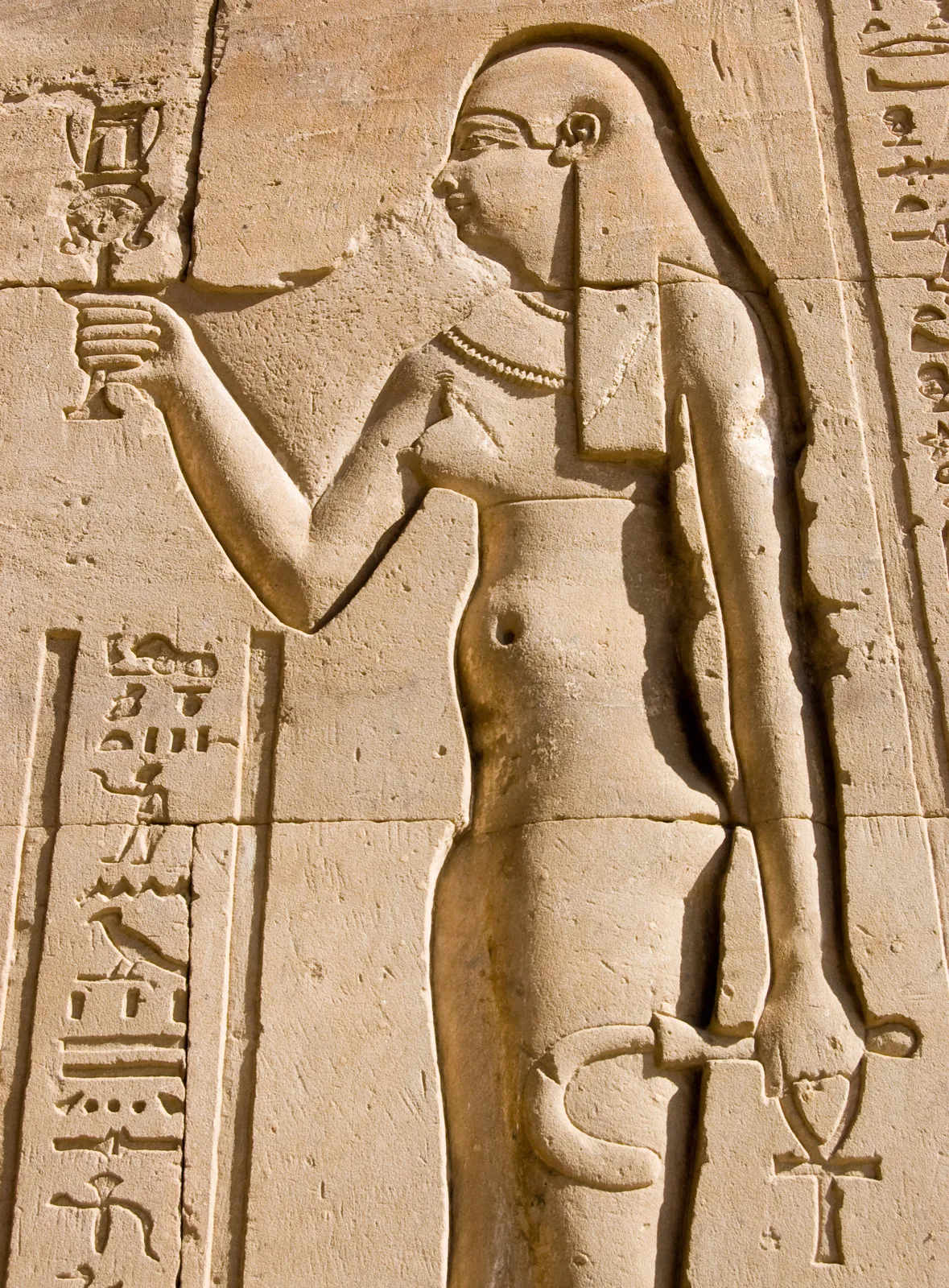
A
superb depiction of Cleopatra taking her own life, unlikely to have been by
the handling of a snake, but could well have been by an asp in a basket of
fruit. Most probably with a concoction of drugs to ease the pain.
More than 2,000 years after her death in 30
BCE, the Egyptian queen Cleopatra still looms large in the popular imagination.
While
the
search continues for the resting place of Cleopatra,
her long lost
missing tomb, the other question on everyone's mind is what the Ancient
Egyptian Pharaoh Queen may have looked like. Was she the
ravishing beauty depicted by Elizabeth
Taylor in 1963? Nobody seems to be able to say for sure, despite mounds
of evidence in the form of carvings and coins that show her as having relatively
unattractive features, with a large chin and nose.
THE
WONDER OF COSMETICS, EYE MAKEUP & SKIN CONDITIONERS
It is known that
Cleopatra VII spent a lot of time in a form of ancient laboratory. She conducted research on herbs and cosmetics. Unfortunately, all the books she wrote were lost in a fire in AD 391, when the great Library of Alexandria was destroyed.
Dr El Daly is quoted as saying: "The most interesting aspect of her image is that of a scholar who made significant contributions in the fields of alchemy, medicine and mathematics. She is shown conducting courtly seminars attended by scientists from different fields, at which she contributed to the discussions as a polymathic scientist."
In the words of the traveller and historian Al-Masudi (d 956): "She was a sage, a philosopher, who elevated the ranks of scholars and enjoyed their company. She also wrote books on medicine, charms and cosmetics in addition to many other books ascribed to her which are known to those who practice medicine."
Cleopatra is held to have been of swathy, dark complexion, taking after her grandmother, a
Seleucid, with some Persian blood. She had luxurious copper hair (most likely made that color by the use of henna).
Cleopatra’s reign as the last queen of Egypt during the Hellenistic period significantly impacted the beauty and makeup trends of her time. She was celebrated for her striking appearance, characterized by her seductive eyes, vibrant complexion, and elaborate hairstyles. Cleopatra’s use of cosmetics, such as kohl eyeliner, bold lip colors, and fragrant oils, became emblematic of her style.
The upper-class women of ancient Egypt sought to emulate the ruling class beauty rituals and adopted similar cosmetic practices. This was also the case with Cleopatra, who was famous for her beauty even in her own time.
We should not overlook the fact that Cleopatra bathed in Donkey's milk to keep her skin toned, and wore revealing dresses that accentuated her female form. In particular, revealing her nipples and breasts. She is said to have had a superb athletic figure, overall, that men find attractive, no matter what the facial
features sitting atop. They could not have taken their eyes off the Egyptian queen. There is also the small matter of having great power, that men find stimulating.
THE MAKEUP CLEOPATRA USED
Cleopatra’s makeup repertoire consisted of several key elements that contributed to her iconic beauty. While the exact details of her beauty regime may not be known with absolute certainty, historical accounts, archaeological discoveries, and artistic depictions provide valuable insights into the makeup she likely used.
Kohl eyeliner was a prominent feature of Cleopatra’s makeup routine. She accentuated her eyes with thick, black lines that extended beyond the eyelids, creating a dramatic and captivating effect. The use of kohl dates back to ancient Egypt and was widely employed by both men and women for cosmetic purposes. Kohl was made from a mixture of lead, soot, and other ingredients and was applied using a small stick or brush.
In addition to kohl, Cleopatra likely used various pigments and dyes to enhance her features. Historical records suggest that she used a red pigment called ochre or cinnabar on her lips and cheeks, creating a vibrant and alluring look. Fragrant oils, such as rose and lily, were also part of her beauty regimen, adding a touch of luxury and enhancing her overall appeal.
Evidence from archaeological findings provides some insights.
Ancient Egyptian tombs and artifacts have yielded remnants of cosmetic containers and tools, including kohl pots and applicators, suggesting the widespread use of these cosmetics during Cleopatra’s time.
Artistic representations, such as sculptures, paintings, and coins depicting Cleopatra, offer visual clues regarding her looks and to extent makeup choices. These depictions often showcase her distinctive eye makeup, accentuated lips, and a regal aesthetic, contributing to the enduring image of her beauty.
The Egyptian privet tree is the source of the dye known as henna, which is a reddish-brown colour. The Egyptian queen was known to wear nail polish produced from this dye. And Cleopatra was known to have her palms decorated with intricate henna designs on a regular basis. In the tradition of the ancient Egyptians who came before her.
The myth of Cleopatra’s exceptional beauty emerged during her lifetime and was perpetuated through history. Accounts from ancient historians, such as Plutarch and Cassius Dio, contributed to the popular belief that Cleopatra possessed unparalleled attractiveness. However, it is essential to consider the subjective nature of beauty and acknowledge that societal standards have evolved over time.
“For she was a woman of surpassing beauty, and at that time, when she was in the prime of her youth, she was most striking; she also possessed a most charming voice and a knowledge of how to make herself agreeable to every one. Being brilliant to look upon and to listen to, with the power to subjugate every one, even a love-sated man already past his prime, she thought that it would be in keeping with her rôle to meet
Julius
Caesar, and she reposed in her beauty all her claims to the throne. She asked therefore for admission to his presence, and on obtaining permission adorned and beautified herself so as to appear before him in the most majestic and at the same time pity-inspiring guise,” wrote Cassius Dio of Cleopatra’s beauty
Cleopatra employed her cosmetics not just for the sake of her own appearance, but also for the potential advantages that came with having a beautiful appearance. Cleopatra, who had
Julius Caesar as her lover and eventually married
Marc Antony, was instrumental in consolidating Egypt’s authority with that of Rome throughout their time together.
Historians depict her as having a commanding presence, alluring charm, and persuasive charisma that transcended her physical features. It is crucial to recognize that Cleopatra’s beauty extended beyond conventional aesthetics, encompassing her intelligence, wit, and ability to manipulate those around her. Ultimately, Cleopatra’s beauty was a multifaceted combination of her physical attributes, personality, and the charisma she exuded as a powerful ruler.
CLEOPATRA EXPERIMENTED WITH CHEMISTRY
Using her chemistry knowledge, Cleopatra won a famous bet against Marc Antony.
According to the legend, Cleopatra and Marc Antony were enjoying a feast when she bet she could spend 10 million sesterces on a single banquet. The next day, she hosted a beautiful banquet that Marc Antony was said to have enjoyed. He also doubted she reached the agreed upon price tag.
For the second course, Cleopatra arranged for a servant to place a vile of vinegar in front of her. With Marc Antony watching, she removed one of her priceless pearl earrings and dropped it in the vile. After the pearl dissolved, she drank the vinegar, thus consuming more than 10 million sesterces in a single sitting. Roman Senator Lucius Plancus declared her the winner of the bet.
Although some scholars say vinegar is not acidic enough to dissolve a pearl, others contend the calcium carbonate in a pearl would indeed react with the acetic acid. And that 5 percent acetic acid solution would take three minutes to react fully with powdered calcium carbonate. The cocktail, however, would likely have a fishy taste that was not enjoyable.
CLEOPATRA PLAYED WITH POISONS
Cleopatra was anticipating Roman forces to destroy her dynasty and tested which poisons would offer her the fastest, least painful death. She used condemned prisoners to experiment on with lethal concoctions.
Using tinctures, which were mixtures of plant extracts dissolved in alcohol, Cleopatra would note how long it took the prisoner to die and which side effects resulted. Some prisoners experienced seizures or nausea, and she wanted to find the perfect poison that would allow her to die quickly and peacefully.
She then experimented with venomous snakes. Her own death has been attributed to cobra venom, but scholars are not in agreement. At the time of her death, Roman occupiers held Cleopatra under house arrest, and they intended to keep her alive. The Romans considered her valuable for maintaining order in Egypt, and it’s unlikely they would have allowed a servant to whisk an angry cobra into her room.
Some historians say Cleopatra likely bit herself to create a wound and then applied the cobra venom topically. Others say she probably drank a lethal mixture of hemlock and opium. Most agree that we’ll never truly know. The first account of her death didn’t occur until decades later.
CLEOPATRA CREATED CURES
Although Cleopatra spent significant time researching the easiest way to die, she also experimented with cures for various ailments. Her invention to cure baldness was made with equal parts of burnt mice, rags, and horse’s teeth. She combined those components with bear’s grease, deer marrow, and reed bark. She then mixed in the last ingredient, honey, to create a salve to rub on the afflicted area until hair began to grow.
Scholars have also attributed books on toxicology and cosmetics to Cleopatra. Egyptians were known for lining their eyes with black makeup. Scientists now understand the makeup contained low doses of lead, which supported the activation of nitric oxide. This helped combat bacterial eye infections.
Cleopatra also formulated skin brightening recipes as well as salves for helping contusions heal. She also might have concocted a painkiller that she eventually used in the
final moments of her
life. Although scholars aren’t certain how her life ended, some think it’s possible she dosed herself with a painkiller to ease her final suffering.
Despite what is known of her brilliance and charm, in mass media depictions what often comes to the forefront is Cleopatra as a ravishingly seductive proto-femme fatale.
Today many historians subscribe to the theory that Cleopatra’s looks -
however pleasing they might have been - were ancillary to her considerable intelligence, learning, foresight, and strategic skills. The image of her as a sultry seductress likely stems from a narrative originally pushed by Octavian (Augustus) to rationalize his rivalry and conflict with fellow Roman
Marc Antony, who was portrayed as having been manipulated by a foreign temptress.
Casting Cleopatra as an evil beauty conveniently downplayed her competence and significance as a ruler.

While Roman historian Dio Cassius described
Cleopatra as “a woman of surpassing beauty,” a number of modern historians have characterized her as less than exceptionally attractive. Nevertheless, they have noted that her beauty was heralded and that her appearance was seductive.
Hardly surprising, given that she is said to have walked bare breasted.
Perhaps, the window dressing was to take attention from her less than
attractive facial features. Or, simply to frame the visage, topped with a
stunning headdress, to (again) draw attention away from her face. A sort of
visual-sexual balancing act.
Greek biographer Plutarch, writing about a century after Cleopatra’s death, presented a less flattering picture: "For her beauty, as we are told, was in itself not altogether incomparable, nor such as to strike those who saw her.” Plutarch, however, was quick to note Cleopatra’s “irresistible charm,” sweet voice, persuasiveness, and stimulating presence.

Cleopatra VII
Philopator was (for sure) the daughter of Ptolemy XII Auletes (80-52BC), Pharaoh of Egypt and
(quite likely) Cleopatra V Tryphaena. There is a marked difference in facial
features between the busts and temple relief's. The one thing the Egyptian
carvings have in common, are the bare breasts. The signature tune of Egypt's
last Pharaoh Queen. Who is said to have asked Isis to be reborn, and made
all the funerary arrangements to thwart Ocavian, should he later realise her
plan to be reincarnated. Cleopatra rightly guessed that the technology to
make that a reality, would one day surface.
In Hollywood movies, Cleopatra has been played by an array of stunning actresses.
Elizabeth Taylor, who was put under the “gaze” as the
“Queen of the
Nile” in the best-known film version of the ruler’s story to date, Cleopatra (1963), is a mainstay on short lists of moviedom’s most attractive leading ladies. One of cinema’s first sex symbols, Theda Bara, invested her Cleopatra with dark sensuality in the lost silent classic
Cleopatra (1917). Before the Production Code reined in sexual suggestiveness, a scantily clad Claudette Colbert caused a sensation in
Cecil B. DeMille’s epic Cleopatra (1934), and Vivian Leigh was the beguiling queen in
Caesar and Cleopatra (1945).
In 2023, Gal
Gadot is said to be limbering up to play the part.
So,
how did this image of Cleopatra come to be?
The obsession with Cleopatra as a stunner started much earlier than movies: it started in literature and drama. In his play
Antony and
Cleopatra, William Shakespeare indelibly etched the queen’s portrait with these words:
"Age cannot wither her, nor custom stale
Her infinite variety. Other women cloy
The appetites they feed, but she makes hungry
Where most she satisfies."
|



